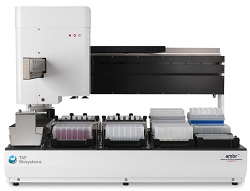AN INDUSTRY consortium has been launched to optimise media and processes in order to manufacture stem cells and natural killer cells at volume.
Based at the Centre for Commercialization of Regenerative Medicine (CCRM), a Canadian non-profit organisation, the consortium includes many of the big names in the bioscience and biotechnology industry. Latest member is Tap Biosystems, which announced its participation today.

Ambr bioreactor from Tap will seek affordable scale-up techniques for commercial therapeutic stem cell manufacture
The company’s Ambr micro bioreactor will be installed at CCRM headquarters in Toronto, where it will be used in experiments to optimise media components and process conditions for cell culture.
Thus requires a fine balancing act between cost and quality, the company reports, because the stem cells and natural killer cells are the final therapeutic product in the process rather than an intermediate step.
This partnership aims to improve understanding of how cells behave in scalable culture formats, so that ‘clinically relevant’ numbers of cells can be produced affordably.
Initial focus will be on immunotherapy applications, with other cell therapy applications to be tackled later.
Tap joins 19 other consortium members who invest in intellectual property and seek to identify bottlenecks and opportunities for regenerative medicine.
The company’s specific role will include development of suspension culture processes in bioreactors that can be applied to commercial manufacture of therapeutic stem cells
“The cost of generating and differentiating stem cells at clinically relevant scale is currently prohibitive, with media requirements sometimes in the range of hundreds of dollars per small scale culture,” said Kim Bure, North American business manager for regenerative medicine at Tap Biosystems.
“Our collaboration with CCRM will define a process to identify the factors and conditions for culture, driving down costs and allowing the production of affordable high quality cell therapies”.
